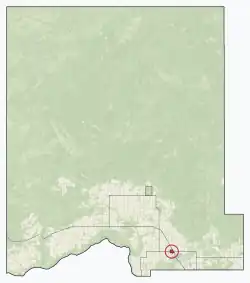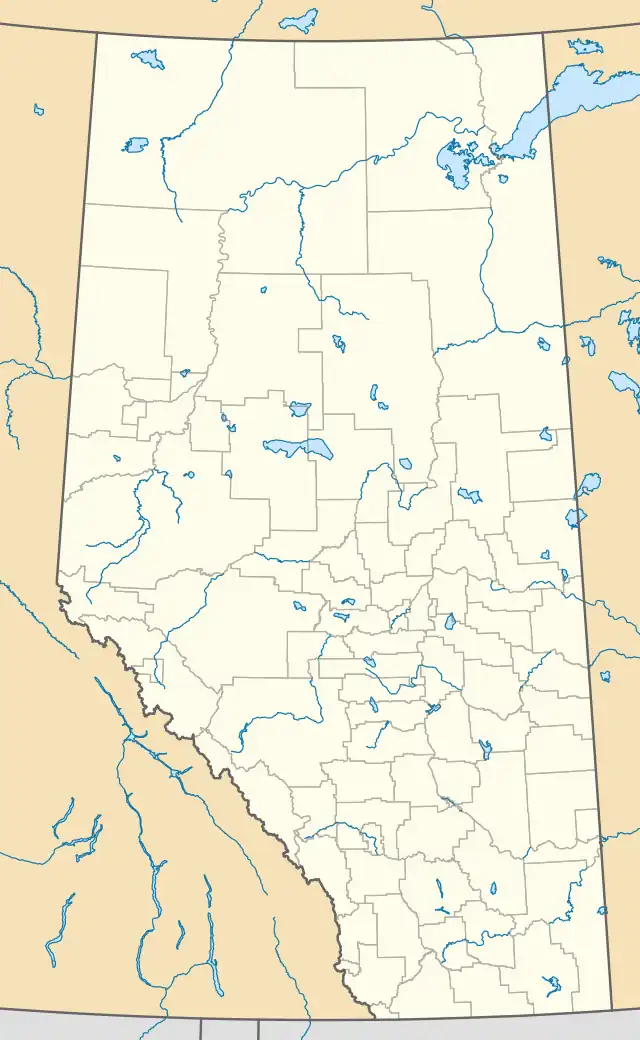Hines Creek
Hines Creek is a village in northern Alberta, Canada. It is located 67 km west of Grimshaw and 28 km north of Fairview, along Highway 64.
Hines Creek | |
|---|---|
| Village of Hines Creek | |
.jpg.webp) | |
| Motto: End of Steel | |
 Location in Clear Hills County | |
 Hines Creek | |
| Coordinates: 56°14′46″N 118°35′38″W | |
| Country | Canada |
| Province | Alberta |
| Region | Northern Alberta |
| Planning region | Upper Peace |
| Municipal district | Clear Hills County |
| Incorporated[1] | |
| • Village | December 31, 1951 |
| Government | |
| • Mayor | Hazel Reintjes |
| • Governing body | Hines Creek Village Council |
| Area (2021)[3] | |
| • Land | 4.88 km2 (1.88 sq mi) |
| Elevation | 655 m (2,149 ft) |
| Population (2021)[3] | |
| • Total | 335 |
| • Density | 68.7/km2 (178/sq mi) |
| Time zone | UTC−7 (MST) |
| • Summer (DST) | UTC−6 (MDT) |
| Highways | 64 |
| Waterways | George Lake |
| Website | Official website |
Demographics
In the 2021 Census of Population conducted by Statistics Canada, the Village of Hines Creek had a population of 335 living in 149 of its 184 total private dwellings, a change of -3.2% from its 2016 population of 346. With a land area of 4.88 km2 (1.88 sq mi), it had a population density of 68.6/km2 (177.8/sq mi) in 2021.[3]
In the 2016 Census of Population conducted by Statistics Canada, the Village of Hines Creek recorded a population of 346 living in 146 of its 151 total private dwellings, a change of -8.9% from its 2011 population of 380. With a land area of 5.33 km2 (2.06 sq mi), it had a population density of 64.9/km2 (168.1/sq mi) in 2016.[11]
Education
Hines Creek Composite School is the only school in Hines Creek and features Grade K-12. It is administered by the Peace River School Division.
Post secondary education is available in the neighbouring town of Fairview at Grande Prairie Regional Fairview Campus.
References
- "Location and History Profile: Village of Hines Creek" (PDF). Alberta Municipal Affairs. October 21, 2016. p. 365. Retrieved October 23, 2016.
- "Municipal Officials Search". Alberta Municipal Affairs. May 9, 2019. Retrieved October 1, 2021.
- "Population and dwelling counts: Canada, provinces and territories, and census subdivisions (municipalities)". Statistics Canada. February 9, 2022. Retrieved February 9, 2022.
- "Table 6: Population by sex, for census subdivisions, 1956 and 1951". Census of Canada, 1956. Vol. I: Population. Ottawa: Dominion Bureau of Statistics. 1958.
- "Table 9: Population by census subdivisions, 1966 by sex, and 1961". 1966 Census of Canada. Western Provinces. Vol. Population: Divisions and Subdivisions. Ottawa: Dominion Bureau of Statistics. 1967.
- "Table 3: Population for census divisions and subdivisions, 1971 and 1976". 1976 Census of Canada. Census Divisions and Subdivisions, Western Provinces and the Territories. Vol. Population: Geographic Distributions. Ottawa: Statistics Canada. 1977.
- "Table 2: Census Subdivisions in Alphabetical Order, Showing Population Rank, Canada, 1981". 1981 Census of Canada. Vol. Census subdivisions in decreasing population order. Ottawa: Statistics Canada. 1982. ISBN 0-660-51563-6.
- "Table 2: Population and Dwelling Counts, for Census Divisions and Census Subdivisions, 1986 and 1991 – 100% Data". 91 Census. Vol. Population and Dwelling Counts – Census Divisions and Census Subdivisions. Ottawa: Statistics Canada. 1992. pp. 100–108. ISBN 0-660-57115-3.
- "Population and Dwelling Counts, for Canada, Provinces and Territories, and Census Divisions, 2001 and 1996 Censuses – 100% Data (Alberta)". Statistics Canada. Retrieved 2019-05-25.
- "Population and dwelling counts, for Canada, provinces and territories, and census subdivisions (municipalities), 2006 and 2001 censuses – 100% data (Alberta)". Statistics Canada. January 6, 2010. Retrieved 2019-05-25.
- "Population and dwelling counts, for Canada, provinces and territories, and census subdivisions (municipalities), 2016 and 2011 censuses – 100% data (Alberta)". Statistics Canada. February 8, 2017. Retrieved February 8, 2017.